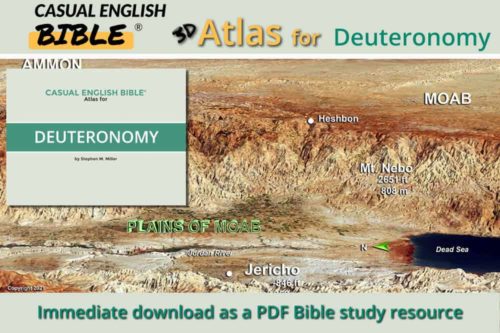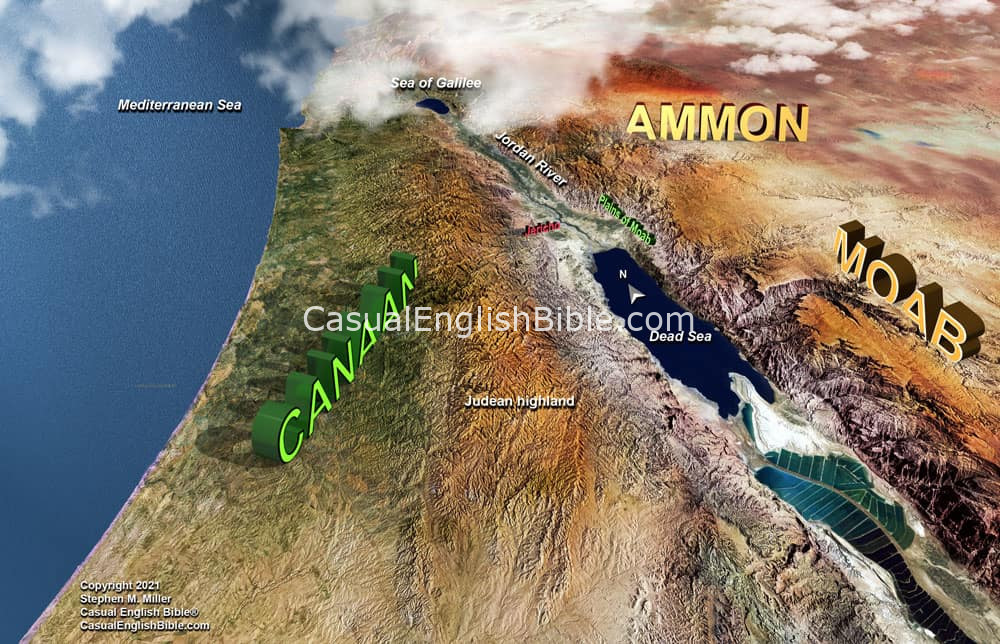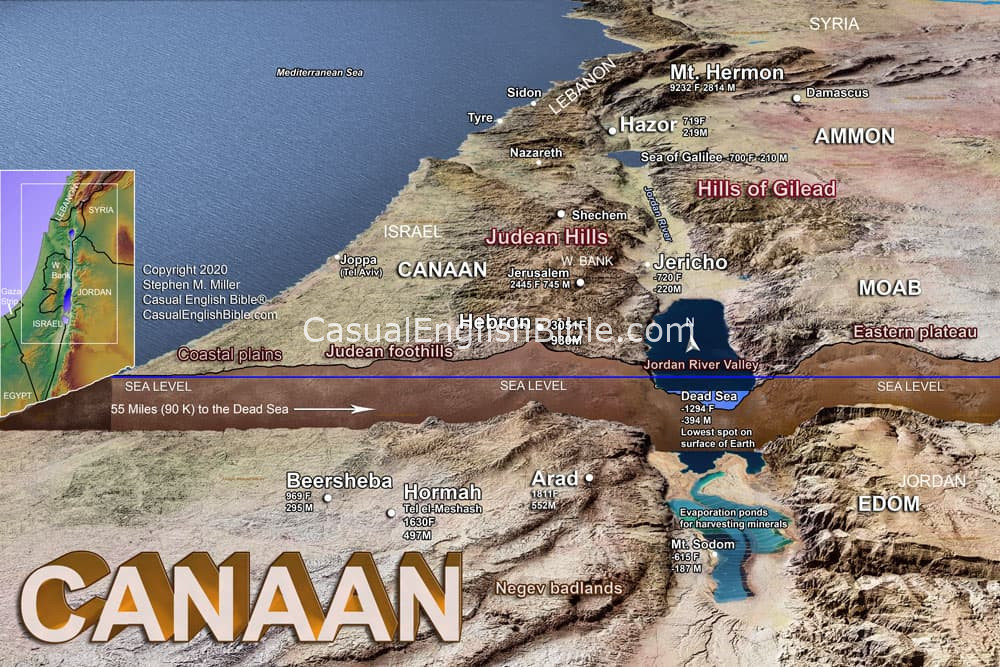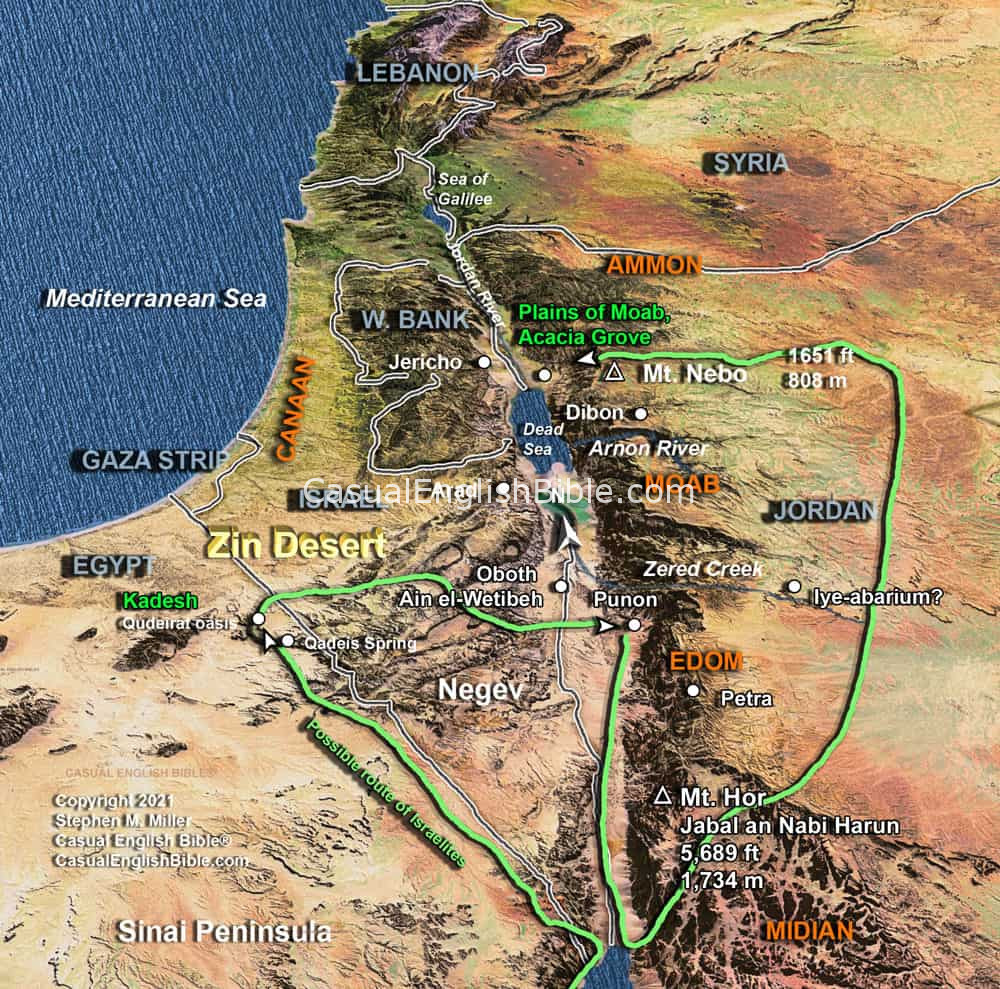Deuteronomy 2
Israelites go to war
Desert road to Canaan
1We eventually moved on, when the LORD told me it was time to go. We headed back into the desert badlands, skirting the hills of Seir, and taking the trail toward the Reed Sea. [1] 2The LORD told me when we had gone far enough. 3He said, “You’ve skirted south alongside these hills long enough. It’s time to turn north. 4Tell the people, ‘You’re headed into a land where some of your relatives live. Esau’s descendants live in Seir. They’re afraid of you. So be careful. 5Don’t provoke them. I’m not giving you any of their land. Not even enough dirt for a footprint. I have already given the hills of Seir to Esau and his descendants. 6When you need food or water while traveling through their land, don’t take it. Buy it.7And don’t forget this: the LORD your God had taken wonderful care of you during all these years in this huge desert wasteland. For 40 years he saw to it you had everything you needed.’” 8We moved on, northward past our relatives descended from Esau and living in the hill country of Seir. We left the Arabah trail behind, along with Elath and Ezion-geber. [2] We turned toward the deserts of Moab. 9The LORD warned me, “Don’t provoke Moab or attack the people there. I’m not giving you any of their land. I already gave this land called Ar [3] to the descendants of Lot.”
Giants from long ago
10(Before Lot, a people known as the Emin lived here. There were a lot of those people, and they made up a strong nation. These people were giants, as tall as the Anakim. [4]
12A people called the Horites [6] used to live in the Seir hill country. But Esau’s descendants ran them off and took their land, just like Israel did in the land the LORD gave them.)
Zered creek crossing
13The LORD told me, “Cross the Zered creek.” [7] 14It took us 38 years to get there, from Kadesh-barnea. An entire generation of adults died during that stretch—all the men old enough to serve in the army. [8] 15The LORD erased them one by one, until they were all gone. 16So, all those men old enough to fight in the army finally died.17Then the Lord said: 18“Today you’re leaving Moab. You’re crossing their border and leaving Ar [9] behind. 19When you cross into Ammon country, don’t attack or provoke the people there. This isn’t the land I promised you. I gave this land to the descendants of Lot.”
More giants from long ago
20(The land of Ammon once belonged to the Rephaites who lived there. The people of Ammon called them Zamzummin.
22That’s exactly what God did for Esau’s descendants who live in the Seir hills. He brought down the Horites who lived there earlier. Esau’s family ran off the Horites, took their land, settled there, and stayed to this very day.
23This also happened to people called Avvim, who lived in the Gaza region. Philistine invaders from Crete [10] ran them off and settled in their land.”
Arnon canyon crossing
24Then the LORD said, “Get moving. Cross the Arnon canyon. Then take a good look at that land ruled by the Amorite king, Sihon, from his capital in Heshbon. I’ve given that land to you. So, take the battle to them. And start claiming their land. 25I’m going to put the fear of God into everyone who hears that you’re coming. People everywhere will tremble at the mention of your name.”Moses offers an olive branch
26When we were still at Kedemoth Desert, I sent messengers to King Sihon in Heshbon. I offered peace. I told him, 27“All we want to do is pass peacefully through your land. We’ll stay on the road. We won’t wander off into fields along the sides of the road. 28We’ll buy food and water from you. Just let us walk across your land.29Esau’s descendants in the hills of Seir let us pass through their land. So did the Moabite people living in Ar.” 30King Sihon of Heshbon rejected the request. The LORD had given him extra doses of stubbornness and arrogance, so the Israelites could defeat him and take his land. 31The LORD said to me, “See what I’m talking about? I’ve already started giving you Sihon and his land. Now, you need to start taking it.”
King Sihon replies with a sword
32Sihon mustered his army and fought us at Jahaz. 33He lost. The LORD our God gave him to us. We took him, his sons, and his people.34We captured all of his cities and we annihilated everyone—men, women, and children. We took no prisoners and left no survivors. We killed them all. 35We kept their animals, though, along with the cities and everything in them that we wanted. 36We took all their territory, with the LORD our God helping us. No city walls were high enough to stop us—from Aroer in the south by the Arnon canyon, to Gilead in the north. 37We avoided people of Ammon—those living in the northern hills and along the Jabbok River. That’s because the LORD told us to.
Footnotes
Many Bibles say “Red Sea.” But the Hebrew words are yam suph, “sea reeds.” It can mean any body of water where reeds grow along the banks. Moses and the Hebrew refugees escaped from the Egyptian army through a path God made in one of these mysterious bodies of water. Scholars usually track Moses and the Hebrews escaping Egypt by walking southeast, out of the Nile Delta fields and toward the Red Sea and the Sinai Peninsula. They would have passed through lake regions along what is now the Suez Canal, which connects the Red Sea to the Mediterranean Sea. These lakes and ponds reportedly had reeds growing along the banks, like the ones the Bible says grew along the Nile River and helped anchor Baby Moses in a basket (Exodus 2:3).
Elath and Ezion-gerber were seaport cities on the northern tip of the Red Sea’s Gulf of Aqaba.
Ar was sometimes apparently used as a nickname for Moab, much like Zion is for Jerusalem. But some scholars say that at other times, as in 2:18, it’s the name of a city in Moab, near the Arnon river canyon. That’s in what is now the country of Jordan.
Descendants of Anak—the Anakites or Anakim—are described as giants (Deuteronomy 2:10-11, see also Numbers 13:22).
Rephaites, whoever they were, remain a mystery. They have been described as an ancient race of giants. Some speculate they were the original people who lived in the region of Bashan, now called the Golan Heights.
Horites show up in Genesis 36:20. Some scholars link them to the Hurrians, people who lived throughout the ancient Middle East, in what is now Israel, Palestinian Territories, Syria, Jordan, and Iraq. But the Horites here are described as the original natives of the Seir hills.
Literally, the Wadi Zered. A wadi is a normally dry pathway that can become a stream or river during a flash flood or in the rainy season of winter.
For refusing to invade Canaan when God ordered it, God told the Israelites, “You’re going to die in the badlands. All the men in your armies—everyone age 20 and older who complained about me—dead” (Numbers 14:29).
This Ar sounds like a Moabite city near the northern border. See also the note about Ar at 2:9.
More literally, the invaders were Caphtorim, people from Caphtor. Scholars say this is likely a reference to the “Sea People,” who in about the 1200s BC, invaded Egypt and what is now the Palestinian region of Gaza, along with the coast of Israel. Scholars suggest that the Caphtor was the ancient name for the Mediterranean island of Crete, and the Caphtorim was the original name of the fierce fighting people who became known as the Philistines.
Discussion Questions
- Sorry, there are currently no questions for this chapter.








